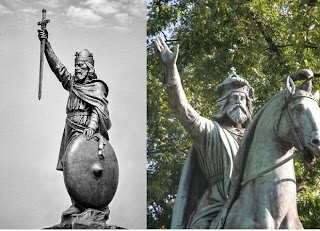The Spitsberg Pirates - that's the name of the player's Viking adventuring company - took some well deserved rest and relaxation back in Trade Town, resting, healing, spending loot, and taking in their experience points. For instance, Brick had been dealing with a case of dungeon lice after sifting through a monster lair , and needed to spend some time scouring himself in the brisk salt waters of the fjord. Valens Lascarius, the Byzantine representative of the High Hermite of Byzantium, was eager to hear if any of the Russian Elves or disciples of Himerius were able to find new sources of magic.
The players were keenly interested to see how "Pig Knuckles" was going. I may have mentioned it here and there, but a long term project for them has been to establish a regular gambling hall back at camp; they scavenged knuckle bones from old skeletons in the dungeon and turned them into dice; they scavenged materials to make gambling tables; they hired guards; cut a deal with the jarl Bergfinn; bought supplies of ale; promoted a key retainer, Skoldig, as the main dealer that runs the games. I built a spreadsheet to calculate nightly results taking into account who runs the games and the competition along with random factors, and then it nets out the winnings after taking out wages and the jarl's 25%. After a few weeks of running the game while they were in the dungeon, the henchmen, retainers, and fellow ship mates have made an extra 400-500sp. By the end of the summer, the captain of the player's ship needs to be able to pay back their lord back home in Zealand who funded the voyage, so this is another way they're accumulating enough cash to make the expedition profitable (note: NPC gambling winnings don't count towards XP).
When all the errands in Trade Town were finally exhausted, they planned another delve. This time, the route was to bushwhack back to Central Command on the surface, take a look at the holo crystal they were carrying while in Central Command's domed structure, then descend to the transit tunnels, and journey north and resume exploring the adamant dungeon.
The holocrystal was another "new employee orientation video" showing the working of some apparatuses in the eastern adamant dungeon; with a skilled weapon-smith, there might be a chance to forge some of the raw adamant they found into weapons. (They filed that information away for now, and stuck to their original plan. Adamant weapons sound pretty good to me, though.)
Back in the adamant dungeon, they started pushing further south into the western wing of the dungeon, clearing a few small chambers and some minor fights, and then discovered a storage area that held a bunch of thulium discs and cylinders. The players don't know all the uses for thulium yet, but they have learned that the discs can activate some of the machinery, like tokens, and learned just in this session that the cylinders act as batteries for other devices (like a wand of magic detection they discovered, or a rod that depowers other items).
One of the recurring monsters in this part of the dungeon are these flying "shockers" - they're like wingless dragonflies, with whip-snap tails that zap anyone they hit. In one of the last rooms, they found a control room overlooking a large chamber with various vat-like capacitors, and a colossal shocker (the mega-shocker) was coiled in this room, slurping electricity from open conduits. Nodules all over its body were buds forming new regular sized shockers, and a handful of the smaller versions clung to the mega-shocker like remoras on a big shark. After noticing the players characters, the mega-shocker reared up and smashed the glass separating them from the overlook chamber; they players chose to flee, running down a passage to give themselves time to think. The players were in this part of the dungeon on another mission for Odin, and their destination required them to get past the mega-shocker, so we'll start this week with an interesting problem.
This was our last game before Christmas, so it was appropriate for some exciting toys to be revealed. Earlier in the evening, while exploring the room where they unleashed an extra-planar entity a few weeks ago, they discovered a few suits of elf-sized plate armor made out of that light-weight adamant. Futuristic and form-fitting, this stylish segmented armor instantly transformed the two 1st level Russian elves into tanks. Timur and Vitaly were ecstatic. I guess it's a happy coincidence that elves are built similarly to space aliens. As far as the players know, Santa was just taking care of some of his elves.
Cast of Characters
Agnar Beigarth, a Northman fighter (L2)
Mustafa of Arabia, a scimitar wielding desert warrior (L3)
Brutok the Strong, a dwarf (L2)
Borghild, a Norse cleric of Odin (L3)
Timur, Russian Elf (L1)
Vitaly, Russian Elf (L1)
Dominicus, Byzantine magic user (L1)
Retainers with the party:
Tribunas, Byzantine magic user (L1)
Brick Bunnybreaker (halfling L1)
Bottvild (cleric L2)
Visin Thorsteinson (fighter 3)
Hunlaf the Saxon (specialist 2)
* Visin and Hunlaf were members of an NPC party that ambushed the players, and were taken prisoner for ransom. After spending a lot of time in tow with the players, Visin grew to have grudging respect for Agnar's leadership (particularly after observing the group's capabilities - two clerics, multiple spell-casters make them a formidable bunch).










